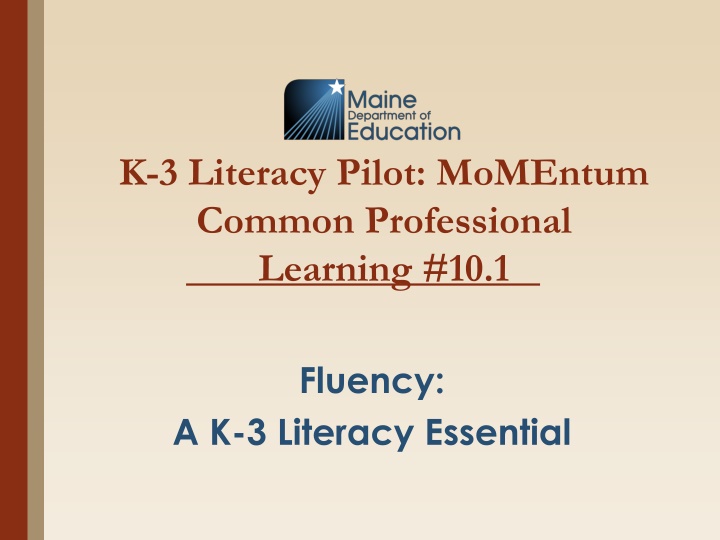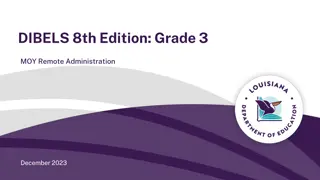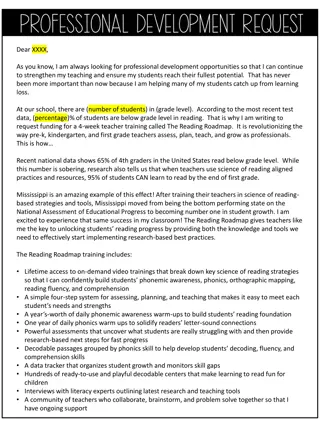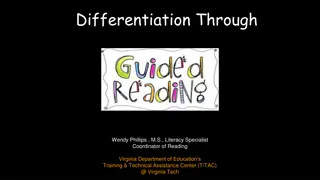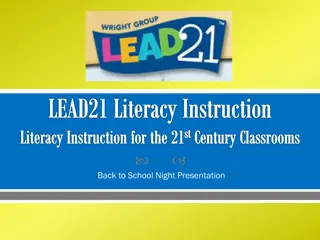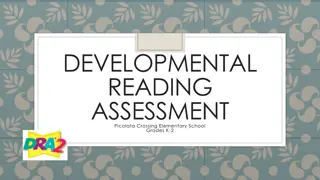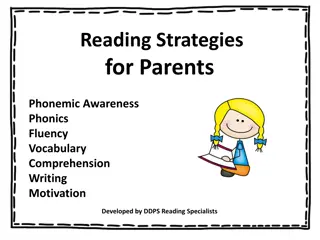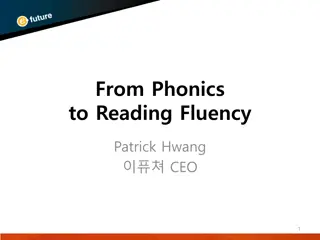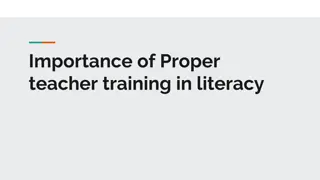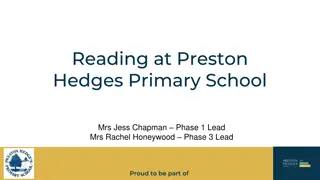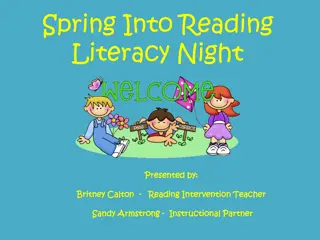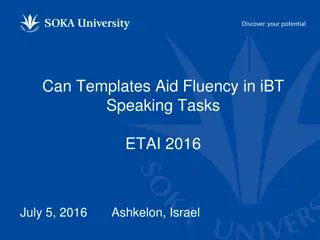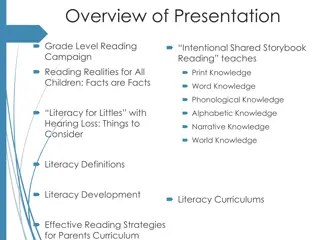Enhancing Reading Fluency in K-3 Literacy: Strategies and Techniques
Educators will explore strategies to improve student fluency in reading, focusing on automaticity, rate, accuracy, and prosody. Reading fluency acts as a bridge between word recognition and text comprehension, with four key components: automaticity, rate, accuracy, and prosody. Techniques such as speed drills, high-frequency word work, and chunking enhance automaticity and accuracy in reading. Connections to research by Hattie and Duke highlight the importance of fluency in developing vocabulary, comprehension, and motivation.
Download Presentation

Please find below an Image/Link to download the presentation.
The content on the website is provided AS IS for your information and personal use only. It may not be sold, licensed, or shared on other websites without obtaining consent from the author.If you encounter any issues during the download, it is possible that the publisher has removed the file from their server.
You are allowed to download the files provided on this website for personal or commercial use, subject to the condition that they are used lawfully. All files are the property of their respective owners.
The content on the website is provided AS IS for your information and personal use only. It may not be sold, licensed, or shared on other websites without obtaining consent from the author.
E N D
Presentation Transcript
K-3 Literacy Pilot: MoMEntum Common Professional Learning #10.1 Fluency: A K-3 Literacy Essential
Learning Intentions Educators will: Experience strategies/ techniques to enhance student fluency each component: Automaticity Rate Accuracy Prosody I know I understand fluency instruction when I can apply: automaticity& accuracy techniques. rate techniques. prosody techniques. close reading.
Fluency How is fluency like the Bucksport Observatory Bridge?
Fluency Reading fluency serves as a bridge between word recognition and text comprehension.
Fluency Four components of reading fluency: Automaticity the ability to read words quickly. Rate the speed at which the text is read. Accuracy the ability to read words accurately. Prosody the appropriate use of intonation, phrasing and expression.
Connections to Hattie and Duke Research John Hattie Phonics Instruction . 45 effect size Nell Duke Modeling/ Demonstrating Explicit Instruction Classroom discussions .82 effect size Close Reading Repeated Readings .67 effect Motivation and Engagement Build Vocabulary Comprehension Fluency
Model Fluent Reading Read Aloud Listen to me read this paragraph. Note how I read each sentence as if I m saying it to a friend. The last sentence ends in an exclamation mark. Listen to the way I raise my voice to show excitement! A reader reads at a good speed and can pronounce all of the word correctly. To become better at pronouncing all words correctly readers may need to read a story many times to read it correctly and at a good pace. Rereading a story can also be a lot of fun. Listen to how I read this sentence. Read it after me in the same way. When you read, think about how I sounded. Did I pause after any words? Did I raise or lower my voice?
Automaticity & Accuracy Automaticity the ability to read and write words quickly. Accuracy the ability to read and write words accurately. Techniques/Strategies for automaticity: High frequency word work Chunking (syllables/nonsense) word work Phrase work Speed Drills Speed drills build fluency because they help students rapidly recognize common syllables and spelling patterns in multisyllabic words.
Speed Drills for Fluency Tips for creating Speed Drills Select skills with which your students need to develop automaticity(i.e., words containing a specific phonics skill or regular and irregular high frequency words). Select either 50 word or 100 word Speed Drill form based on the age of your students. Select 20 25 words to include on the speed drill. Write the words in random order, multiple times, on the speed drill form. Make copies of the speed drill for students to use. Allow students time to practice reading the words on the speed drills independently.
Try It On Automaticity & Accuracy
Rate Rate the speed at which the text is read or written. Techniques/Strategies for rate: Reading aloud simultaneously with a partner. Echo reading. Choral/Shared Reading Paired repeated readings. Books on iPad. Repeated readings. Shared, Interactive & Writing Workshop
Try It On Rate
Prosody Prosody the appropriate use of intonation, phrasing and expression. Techniques/Strategies for prosody: Reading punctuation. Reading with intonation and expression. Reading dialogue. Phrased cued text practice. Reader s Theater
Try It On Prosody
Putting It All Together Close Reading Teacher Version Close reading is purposefully reading a complex text several times in order to analyze and gain a deep understanding of the text. Student Friendly Version Reading something enough times so you can understand it, explain it to someone else, and ask and answer questions about it using evidence from the text.
What Does a Close Reading Routine Look Like? Establish purpose for reading, activate prior knowledge of text/genre structure and topic vocabulary Engage in 1streading read aloud or independently with annotation Engage in 1stdiscussion checking for basic understanding, sharing surprises and confusions Engage in 2ndreading may be shared reading and/or teacher read aloud/think aloud, use of text-dependent questions to prompt analysis Engage in 2nddiscussion examine and extend on 2ndreading Engage in 3rdreading using text dependent questions to prompt analysis Engage in 3rddiscussion students share evidence Writing about text connected to big ideas surfaced through readings/discussions and which requires textual evidence to be included.
Try It On Close Reading
Try It On Try grouping your students by fluency strategy. Co teach or co plan the lesson with your coach. Try a reader s theatre whole class or small group. Plan with your coach during a pre-conference. Use your iPad to teach/ automaticity with high frequency words in reading and writing. Seek out your coach for assistance. Use your iPad to record and provide feedback on student oral reading. Ask your coach to assist.
Try It On! Have students record their reader s theatre performance using their iPad and share with others. Use EPIC for listening to fluent reading. Use the phrased cued text passages to teach proper phrasing. Your coach can be a thinking partner as you try it on. Use Mark Up to visually scoop words together to teach phrased reading. Use Book Creator and Showbie to record and share students reading rereading to increase fluency and understanding.
Success Criteria Educators will: Experience strategies/ techniques to enhance student fluency each component: Automaticity Rate Accuracy Prosody I know I understand fluency instruction when I can apply: automaticity& accuracy techniques. rate techniques. prosody techniques. close reading.
